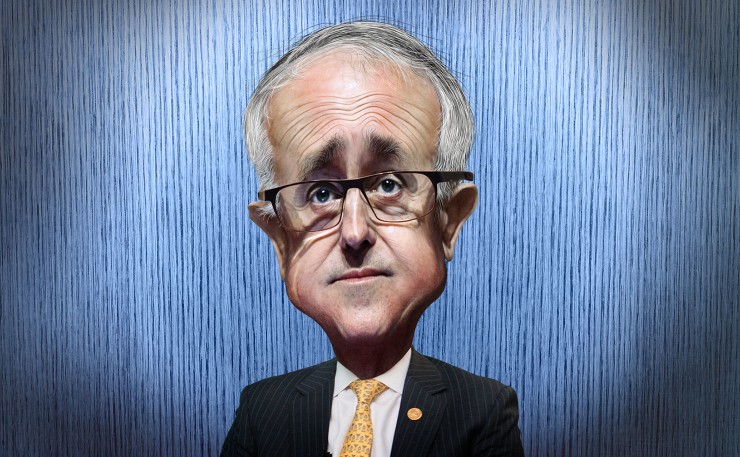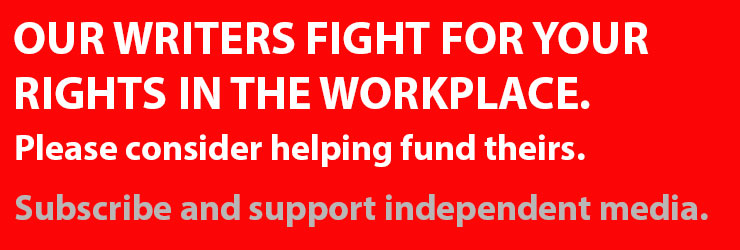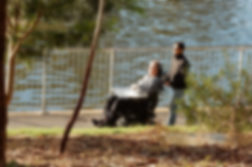We look increasingly likely to head to a double dissolution election. Michael Brull weighs in on the likely election battleground.
‘Moneybags’ Malcolm Turnbull has gone ahead and called Tony Abbott’s election. Abbott claims that Turnbull is running on the Abbott government’s record. In itself, that claim is ridiculous. Abbott’s legacy was toxic, and Turnbull will do his best to act like his policies are radically different from those of Abbott.
Even so, Abbott is being modest. Abbott chose the election battlefield that Turnbull will fight on.
Remember: half a year ago, conservative former High Court Justice Dyson Heydon was trying to explain why speaking at a Liberal Party fundraiser wasn’t a sign of bias. He claimed it wasn’t a fundraiser, it wasn’t really a Liberal Party event, and even if it was, that didn’t prove he’d be biased in hearing out submissions on trade unions.
And so Heydon went ahead and produced his Final Report for the Royal Commission into Trade Union Corruption and Governance (TURC) on 28 December 2015.
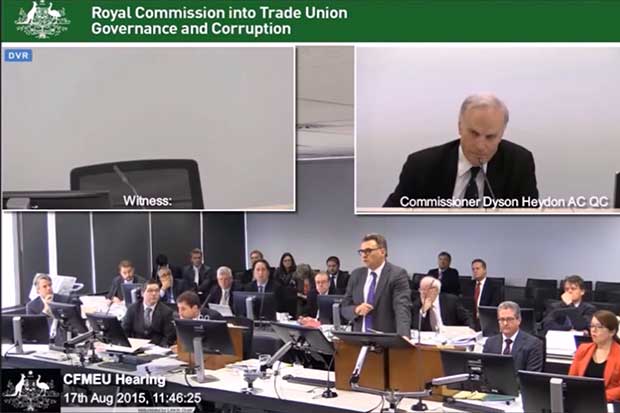
The goal was never hard to understand. Abbott ordered his royal commission, in the hope it would produce lurid stories about trade unions, and associate them in the public mind with corruption. Sadly for Abbott, Heydon was soon associated with his Liberal party fundraiser.
Dyson’s verbose and dogmatic defence of his objectivity seemed to indicate less a dispassionate weighing of the issues than a desperate desire to continue on as Royal Commissioner.
I charitably thought that Heydon would still produce a more or less objective report. It would give the Liberals their strongest case against the Unions. In the end, that case didn’t amount to much.
In the overview, Heydon announces: “[The] Commission uncovered and examined a wide range of corrupt or inappropriate conduct on the part of some union officials”. He then lists 11 alleged incidents.
One incident is two cars being purchased with union funds for two officials joining and leaving the Trade Workers Union in Western Australia. Another is a former president of the Construction, Forestry, Mining and Energy Union (CFMEU) getting $150,000 of free work on his home from a major building company.
Heydon does his best to expand on his findings. He found “widespread misconduct that has taken place in every polity in Australia except for the Northern Territory.” He announces that, “You can take any rank of officeholder, from Secretaries down to very junior employees. You can search for any type of misbehaviour. You will find rich examples over the last 23 years in the Australian trade union movement.”
One suspects that if you looked into any area of work over the last 23 years, you might find incidents of corruption.
And then comes Heydon’s backtracking: “Of course what has been described is not universal. It may not even be typical.”
Here’s another quietly ambivalent claim of a systemic problem: “These aberrations cannot be regarded as isolated. They are not the work of a few rogue unions, or a few rogue officials. The misconduct exhibits great variety. It is widespread. It is deep-seated. Nor can the list be regarded as complete. It would be utterly naïve to think that what has been uncovered is anything other than the small tip of an enormous iceberg. It is inherently very hard to identify most types of misconduct by union officials.”
So they are aberrations, but are not isolated? What, then, is an aberration? If this is the “small tip of an enormous iceberg”, perhaps Heydon is admitting that he didn’t really find much after all. It may be hard to find the misconduct he is investigating, but how do we know that there is actually more to find?
In the end, Heydon may have been satisfied that he found enough anecdotes of wrong-doing to call the problem systemic. Yet not every tip has an iceberg.
The fact is that Heydon seems to have been unsatisfied by what he found. Yet still, after spending $50 million on his investigations, Heydon seems to think more needs to be done.
Taxpayers may wonder how much more we should expend on a hunch which produced so little.
And now, a few months after the report was released, it is bearing political fruit. As my colleague Thom Mitchell explains, reviving the Australian Building and Construction Commission is a way to put a “tough cop on the beat”, policing unions in the construction and building industries.
The ABCC, if it is re-established, will be able to compel workers to answer questions, deny them the right to silence and legal representation whilst being questioned, and enter premises without warrants.
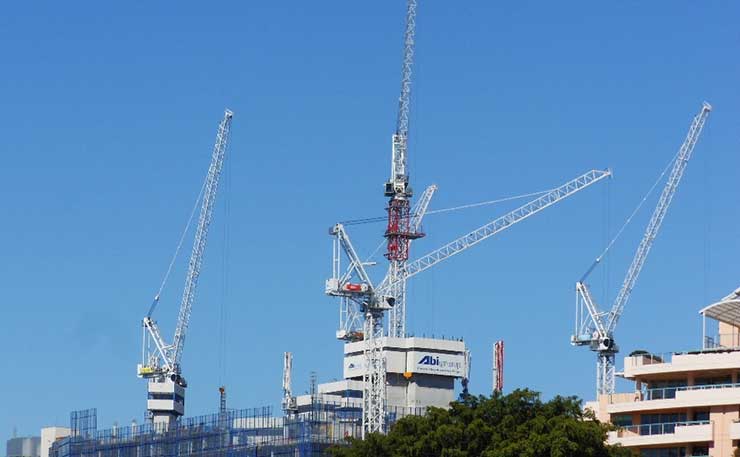
Workers can also be compelled to produce documents and information on request.
Why is Turnbull targeting the CFMEU? Well, a brief look at the TURC explains why.
I’ll just look at how the TURC deals with two unions. This can be found in Volume 1 of Heydon’s Final Report. On the one hand, we have the CFMEU:
“Then there is misconduct on building sites directed to employers, contractors and government inspectors all over the country from Brisbane to Sydney to Melbourne to Adelaide, and generally carried out by more junior officials.
But senior officials can be involved as well. At a blockade of a Grocon site by the CFMEU a driver of a minibus, who happened to be suffering from cancer, attempted to drive out of the blockaded area.
He described how CFMEU members surrounded his van, yelling abuse and punching the windscreen. One of them was John Setka, then Assistant State Secretary, who was found by Tracey J to have used foul and abusive language, to have punched the windscreen, and to have shouted: ‘I hope you die of your cancer’.
Is this in the great Keir Hardie traditions of fraternal solidarity in the face of monopoly capitalism? Nor did John Setka confine his foul and abusive language to blockades. He repeatedly employed the same tactics, using words which will not be repeated here.”
Goodness. Such rude conduct in the face of an employer. Such militant tactics, such hatred. And even “words which will not be repeated here.”
That is at the start of Volume 1, which gives an overview of Heydon’s findings. Later, Heydon identifies some common themes from his report. One is creating false records. An example Heydon gives is the CFMEU destroying “tonnes of documents”, rather than turning them over to TURC.
Then Heydon discusses another type of misconduct that can be found in the trade union movement. As will be seen, Heydon singles out a particular union: “A third theme revealed by some of the case studies, particularly those involving the AWU [Australian Worker’s Union], involves the payment of large sums by employers to the union. “
Heydon continues: “Arrangements of this kind are highly unsatisfactory. They inhibit the ability of the union and its officials to pursue the interests of its members. The union and the officials become the servants of two groups of masters. They tend to end up, if not loving one and hating the other, at least showing favour to one, the employer, and failing energetically to advance of the position of the other, the members”.
Heydon goes on to note that in the case of cleaning company Cleanevent, the:
“…documentation gives a very clear indication of how highly disadvantageous these arrangements can be for members. In exchange for payments of $25,000 per year, the Victorian Branch of the AWU in substance agreed for three years not to seek better terms and conditions for those of its members employed by Cleanevent.
It would not have been difficult to obtain better terms and conditions. But the Victorian Branch of the AWU preferred to take the fairly paltry sum of money for itself. For workers employed by Cleanevent the outcome was appalling.
The members of the Cleanevent management team involved in the deal described it as saving the company amounts ranging from $1 million to $2 million. All involved benefited from the deal except the people the union was supposed to be representing.”
I don’t want to over-idealise the CFMEU. Heydon makes a case of issues of corruption across various trade union organisations. These are serious issues, and provide a good reason for trade unions to engage in internal reform.
They also highlight the difficulty inherent in trade unionism. That is, if an industry has hundreds of thousands of workers, and then a few hundred union officials, their interests may not always dovetail. Indeed, for union officials who represent vast numbers of workers, they may personally be better off reaching an accommodation with their supposed adversaries in business, than aggressively fighting for the rights and conditions of the people they represent.
Yet that is not who Turnbull has chosen to go after. The ABCC isn’t going to target the Union which “particularly” had the issue of getting secret payments to advance the interests of employers. It’s going to target the militants in the CFMEU, whose senior officials swear and blockade and hope that some workers die of cancer.
Why might the CFMEU be so militant? Here’s a clue. Safe Work Australia provides a table of workplace deaths each year.
Year-to-date 2016: worker deaths by industry of workplace
| Industry of workplace | Total worker deaths 2013 | Total worker deaths 2014 | Total worker deaths 2015 | Worker deaths year-to-date 2015 | Worker deaths year-to-date 2016 |
| Transport, postal & warehousing | 52 | 48 | 55 | 9 | 7 |
| Agriculture, forestry & fishing | 52 | 47 | 55 | 6 | 5 |
| Construction | 17 | 29 | 26 | 4 | 5 |
| Miningb | 10 | 13 | 13 | 4 | 0 |
| Manufacturing | 14 | 12 | 10 | 3 | 0 |
| Administrative & support services | 1 | 4 | 6 | 2 | 0 |
| Arts & recreation services | 10 | 12 | 7 | 1 | 0 |
| Electricity, gas, water & waste services | 7 | 3 | 7 | 3 | 1 |
| Other services | 4 | 1 | 4 | 3 | 1 |
| Accommodation & food services | 3 | 5 | 2 | 0 | 0 |
| Health care & social assistance | 2 | 2 | 2 | 0 | 0 |
| Public administration & safety | 5 | 3 | 3 | 0 | 1 |
| Retail trade | 6 | 0 | 2 | 0 | 0 |
| Government administration & defence | 1 | 2 | 1 | 1 | 0 |
| Education & training | 0 | 0 | 0 | 0 | 0 |
| Financial & insurance services | 0 | 0 | 0 | 0 | 0 |
| Information media & telecommunications | 1 | 0 | 0 | 0 | 1 |
| Professional, scientific & technical services | 0 | 0 | 0 | 0 | 1 |
| Wholesale trade | 4 | 6 | 0 | 0 | 0 |
| Total worker deaths | 189 | 187 | 193 | 36 | 22 |
As you can see, since 2013, some of the most dangerous jobs include construction, mining, and agriculture, forestry and fishing. Three of the areas which the CFMEU campaigns on. There were 26 deaths in construction last year. Imagine what kind of action the government might have taken if those people had been killed by jihadi terrorists, rather than by unsafe working conditions.
Furthermore, these conditions have been unsafe for a long time. A report from Safe Work Australia shows that from 2003 to 2013, 401 construction workers died from workplace injuries.
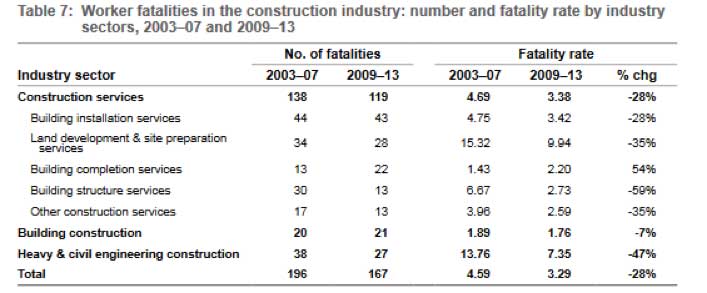
Another report observed that, “In 2012–13 the construction industry had the 4th highest incidence rate of serious claims per 1,000 employees and 5th highest fatality rate per 100,000 workers in 2013–14.” Furthermore, “In 2012–13 the construction industry accounted for 9 per cent of the Australian workforce but 10 per cent of workers’ compensation claims for injuries and diseases involving one or more weeks off work. In 2013–14 the construction industry again accounted for 9 per cent of the workforce but accounted for 12 per cent of work-related fatalities. 12,600 construction worker’s compensation claims “are accepted from the construction industry each year for injuries and diseases involving one or more weeks off work. In the construction industry this equates to 35 serious claims each day.”
That is, the CFMEU has a lot to fight for. The construction industry work is poorly regulated and unsafe, it injures and maims workers every day, and it kills workers every week or two. Instead of Moneybags Malcolm regulating the industry to make it safer, he is choosing to launch an attack on workers fighting to defend themselves and their safety.
Perhaps launching an attack on unions in the building and construction industries will help make them more profitable. Perhaps it will unite the conservative Abbott faction of the Coalition behind Turnbull. If Turnbull is particularly lucky, it might even stop Abbott from a long election campaign of leaks, sabotage and internal wrecking.
The Royal Commission gave some indication about what types of unions were corrupt, and how.
Some unions fought in sometimes corrupt ways for their members. Others corruptly collaborated with employers to screw their members out of better working terms and conditions. It is not surprising that Turnbull has decided to pick on one set of unions rather than the other. But we should be clear about why that is. And we should be clear about the kinds of things they are fighting for.
Justice Heydon expressed horror at the CFMEU workers who yelled abuse at a man who had cancer. One man even wished that that man with cancer should die from it. Cancer is awful, and that was a nasty thing to say. Yet so is a status quo where dozens of workers die every year from unsafe working conditions, the kind of working conditions that would never imperil someone like Turnbull or Heydon.
It is no less nasty to target those fighting for safer conditions, instead of targeting those who impose unsafe conditions in the first place.
It is nasty, and it is cruel for one of the richest men in Australia to fight an election to strip away the rights and working conditions of some of the most vulnerable workers in Australia.
Donate To New Matilda
New Matilda is a small, independent media outlet. We survive through reader contributions, and never losing a lawsuit. If you got something from this article, giving something back helps us to continue speaking truth to power. Every little bit counts.

